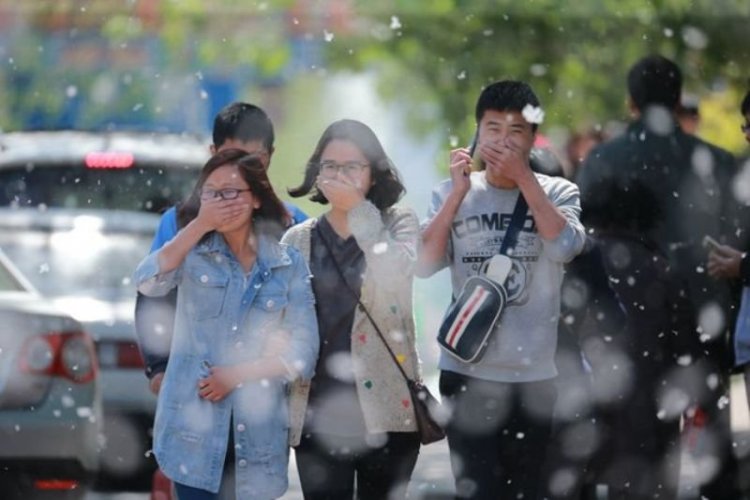Just How Does Beijing Monitor Its Air Pollution? A Visit to the BMEMC
As Beijing works to bring its smog under control, we recently discovered that you can take tours of the Beijing Municipal Environment Monitoring Center (BMEMC). In fact, we even visited the center so we could report back. Here’s our account of our bemusing tour, and some details on how you can check it out yourself.
Getting to know our tourmates
When you register, the BMEMC offers a choice between general public tours and media tours. We opted for the former, but still saw others in our group show up with giant cameras and boom mikes. Hmm. There also seems to be a good chance of running into student groups who are also curious about the air quality (and concerned about their health). On our trip, these students were given blank sheets of paper, to be filled in with correct answers about air pollution. Don’t worry, you won’t be getting a pop quiz if you go … unless you want one.
The tour itself
Presenter #1 gives some background information about the BMEMC. She demonstrates great feats of memorization as she regurgitates everything – at great speed – that’s written on three giant boards on the wall.
Next, Presenter #2 shows slides on how the testing process works, but there are no photos of the actual process (just some trucks), so it is not entertaining in any way, just very straightforward and educational. Though the technical processes can be complicated, he manages to explain everything within 15 minutes. There is a question and answer section at the end of his speech but he doesn’t speak English.
Finally, Presenter #3 is in charge of explaining what API is and what the national standards are. This is the part we're interested in, but she talks super fast, so if you care to hear what she’s saying, bring a recorder.
Main points
- There are 27 sampling stations in Beijing. Of these, 12 are national and 15 are Beijing’s own. Beijing’s API is an average of the samples from those 12 national stations.
- The API is from the last 24 hours only (continuous monitoring). A rating of 100 is said to be normal but different particles individually have different standards. For example, for NO2 (nitrogen dioxide), anything beyond 120 is hazardous, while for other particles the threshold number is 150. If any of the individual measures exceed their limits, the general index will indicate substandard air quality.
As you can imagine, the tour itself was not terribly informative. However, the Q&A sessions were amusing, if unintentionally so. Here are some highlights.
Best of the Q&As
Q: "If a normal standard would be 100, what’s heavily polluted and how many such days do we have per year?"
A: "201-300* would be extremely polluted and even people who are healthy should try to stay indoors as much as possible. We get about ten heavily polluted days per year." [ … Really? –Ed.]
Q: [asked by a mom] "When API is 'beyond index,' what can we do to protect our children, and what kinds of masks or clothing should we prepare?"
A: "Not sure. We are only a testing center."
Q: "How many times does Beijing go beyond index per month?"
A: "Summer, July and August are the best in terms of air quality. March and April are the worst while winter with heating is pretty bad as well." [Good to know, but answer the question! –Ed.]
Q: [asked by a child] "Will there be a policy in place in the future to warn people not to go to work or school?"
A: "Not sure. We are only a testing center."
Q: [asked by a dad] "What about that artificial rainfall technique? Can’t we improve the air by making rain or wind?"
Q: [asked by a kid] "How can we know whether the wind isn’t bringing more pollution from elsewhere?"
A: "As a testing center, we can only answer questions related to testing."
Q: "Will English-language tours be available in the future?"
A: "No plans as of yet."
Q: "Where is the bathroom?"
A: "Not sure. We are only a testing center."**
*We demystified these numbers for you in this blog post a couple months ago, so have a look for more details. Or check out the January issue of our magazine.
**OK, this last one didn’t really happen.
To reserve a tour:
Visit the BMEMC's official site (Chinese-language only), where you can download an application form. Fill out the form and send it back to bangongshi@bjmemc.com.cn. They will call you to arrange a time.
Things to keep in mind:
- No actual processes will be shown so don’t expect any visual elements except photos
- There will be no seating in the room and the entire tour will take 45 minutes, followed by a question & answer session and a survey.
- Tours are only available on Tuesdays, so plan ahead.
Photos: Ecoautoninja.com, Max Wu
Related stories :
Comments
New comments are displayed first.Comments
![]() mikei
Submitted by Guest on Mon, 03/05/2012 - 22:02 Permalink
mikei
Submitted by Guest on Mon, 03/05/2012 - 22:02 Permalink
Re: Just How Does Beijing Monitor Its Air Pollution? A ...
All I can say is totobobobeijing.com
Validate your mobile phone number to post comments.


